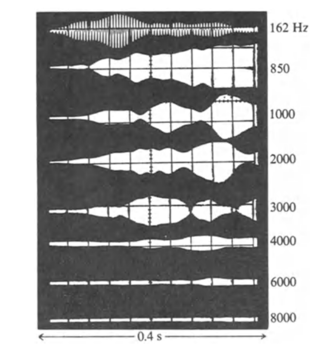Why the mass spring system prefers to oscillate at natural frequency, why does it rather oscillate at other frequencies? Every object in the universe is always vibrating, is it true? if it is the mass spring system at equilibrium, the atoms/molecules inside the systems are still vibrating with a natural frequency.
5 Answers
Why the mass spring system prefers to oscillate at natural frequency, why does it rather oscillate at other frequencies?
Because the math tells us so!
For a bob of mass $m$ connected to a Hookean spring with constant $k$ the Newtonian equation of motion is:
$$ma=-kx$$
Or with $a=\ddot{x}$, we get:
$$\ddot{x}+\frac{k}{m}x=0$$
Or with $\omega^2=\frac{k}{m}$ $$\ddot{x}+\omega^2 x=0$$
which has the known solution:
$$x=c_1\sin\omega t+c_2\cos\omega t$$
That is the mathematical description of an oscillator. The integration constants $c_1$ and $c_2$ are determined from the initial conditions (I've not specified these here).
$\omega$ is the natural angular velocity:
$$\omega=\frac{2\pi}{T}\Rightarrow T=\frac{2\pi}{\omega}\Rightarrow T=2\pi\sqrt{\frac{m}{k}}$$
with $T$ the period of oscillation. This system will only oscillate at a different period/frequency in the case of a driven oscillator.
Every object in the universe is always vibrating, is it true?
No. Look at a mass/spring system where the mass is kept at equilibrium point ($x=0$) briefly. It will not oscillate or start to oscillate.
Things actually don't vibrate at just one frequency. That's a simplification. It happens to be a good simplification for a heavy mass on a spring that's oscillating a small distance.
Your title question cannot be answered without math because we have to define "natural frequency." With math, we can describe that using variables and equations. Without math, what does "natural frequency mean?" If we describe it as "the frequency an object naturally vibrates at," then our terminology has failed us. We now have a tautology. Objects vibrate at their natural frequency because that is the frequency they vibrate at.
The question in your body is more interesting. Why do some things oscillate at frequencies other than their natural frequency. To answer that, we need to remember that the simple model of a mass and spring that we use to describe simple vibration is just a simplification of the real thing. To bring a math term in, its the linearized version of vibration. Some systems, like the heavy mass on a spring, are already very linear, so this simplification works pretty darn well.
Other systems are highly non-linear. In non-linear systems, we see vibrations at other frequencies. The nice easy linear equations which yield a single frequency give way to much more complex and beautiful equations.
The ultimate example of this that I know if is the gong. I asked a question a few years back as to why you "warm up" a gong. When you play a gong, you don't just smack it. You first tap it several times, sub-audibly. Then, once it is "warmed up" you strike it so that the audience can hear. It's an odd ritual, but it matters for the gong because the gong is incredibly non-linear. In fact, its rather chaotic. Warming up the gong helps put energy into the gong in a way that lets the whole gong resonate with a brighter sound.
Non linear systems are not bound to oscillate at a given frequency. They can transfer energy between frequencies. The result is the characteristic shimmering gong sound.
So in the end, the idea of a natural frequency is only a simplification. The realty of movement is much more complex. However, in many cases, this simplification is sufficient.
For an intuitive explanation, imagine pushing a child on a swing. Once the swing starts moving, you wait to push it again until it reaches the high point of its backwards motion. If you try pushing the swing when it is already swinging forward, it is not going to be as effective. If you try pushing the swing while its swinging backwards, you're pushing against the motion of the swing, so you are actually slowing it down. By timing your pushes just right, you can maximize the effectiveness. The natural frequency of the swing has to do with the amount of time it takes the swing to move through one cycle. If you synchronize your driving force with the natural cycle, you'll get the largest oscillations. Oscillations of other things are more complicated, but the same basic principle applies.
I don't believe that the phenomenon is caused by math although it is hard to explain without using some math. The reason is that if a system is pushed slightly out of equilibrium, there is a force that opposes this. This force is proportional to the deviation, for example the displacement of a string or a pendulum. This leads to the equation of motion $$m \ddot x = k x~,$$ where k is a so called spring constant. The solution of this is $$ x = \sin \omega t$$ with natural frequency $$\omega = \sqrt{k/m} ~.$$ Voila the harmonic oscillator. For larger deviations the right hand side may contain higher orders of $x$ and this causes anharmonic behavior.
The frequency depends on the spring stiffness, k, and the mass, m, as the math shows. For a more intuitive explanation, suppose we watch as the mass moves through the middle (equilibrium) position and the spring starts to stretch. There are two competing factors: the stiffness of the spring, which wants to pull the mass back to the equilibrium position, and the inertia of the mass, which wants to have the mass continue to stretch the spring. For a given system (k and m), these competing factors will determine how often the mass goes back and forth i.e. the frequency. As the equation for the period of oscillation, T, shows, the larger the mass the larger is T; the larger the stiffness, the smaller is T. To get the actual dependence on m and k does require the math.

